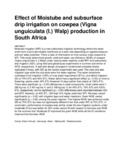Effect of Moistube and subsurface drip irrigation on cowpea (Vigna unguiculata (I.) Walp) production in South Africa
Date
2020-04-29Author
Kanda, Edwin Kimutai
Senzanje, Aidan
Mabhaudhi, Tafadzwanashe
Metadata
Show full item recordAbstract
Moistube Irrigation (MTI) is a new subsurface irrigation technology where the water emits from a semi-permeable membrane at a slow rate depending on applied pressure and soil water potential. There is lack of information on how various crops respond to MTI. This study determined growth, yield and water use efficiency (WUE) of cowpea (Vigna unguiculata (L.) Walp) under varying water regimes under MTI and subsurface drip irrigation (SDI), using field and glasshouse experiments in summer and winter of 2018, respectively. A split-plot design arranged in randomized complete blocks, replicated 3 times, with SDI as the control experiment was used. The main plot was irrigation type while the sub-plots were the water regimes. The water treatments consisted of full irrigation (100% of crop water requirement (ETc)), and deficit irrigation (DI) of 70% ETc and 40% ETc. Water deficit had a significant effect (p < 0.05) on time to flowering; plants under 40% ETc flowered 14 days earlier than plants at 100% ETc. There were significant (p < 0.05) differences in yield components. Grain yields were 1 280 kg.ha(-1) 2 401 kg.ha(-1) and 3 189 kg.ha(-1) for 40% ETc, 70% ETc and 100% ETc, respectively, but no significant (p > 0.05) differences were recorded between SDI and MTI. However, at 40% ET,, SDI had 15% higher yield than MTI. Biomass varied significantly (p < 0.05) with irrigation type and water treatment. Grain WUE varied significantly (p < 0.05) among the water regimes. The highest WUE was achieved under SDI at 70% ETc but was not significantly different from that under MTI at 70% ETc. In conclusion, performance of cowpea was similar under the two irrigation systems under moderate DI but was better for SDI under severe DI with respect to biomass and WUE for the summer trial. Moderate DI improved the grain WUE while all the DI conditions improved the biomass WUE
URI
https://doi.org/10.17159/wsa/2020.v46.i2.8234https://www.ajol.info/index.php/wsa/article/view/195940
http://r-library.mmust.ac.ke/123456789/1515
Collections
- Journal Articles [411]

